A Low-Cost Radar-Based IoT Sensor for Noncontact Measurements of Water Surface Velocity and Depth
Abstract
1. Introduction
2. Materials and Methods
2.1. Sensor Design
2.1.1. Electrical and Physical Overview
2.1.2. Radar Lens
2.2. Data Processing
2.3. Power Usage
2.4. Lab Characterisation
2.5. Field Trial
3. Results
3.1. Lab Characterisation
3.2. Field Trial
3.3. Comparison with the Literature
4. Conclusions
Supplementary Materials
Author Contributions
Funding
Institutional Review Board Statement
Informed Consent Statement
Data Availability Statement
Conflicts of Interest
References
- Lim, S.-R.; Suh, S.; Kim, J.-H.; Park, H.S. Urban Water Infrastructure Optimization to Reduce Environmental Impacts and Costs. J. Environ. Manag. 2010, 91, 630–637. [Google Scholar] [CrossRef] [PubMed]
- Fallah Shorshani, M.; Bonhomme, C.; Petrucci, G.; André, M.; Seigneur, C. Road Traffic Impact on Urban Water Quality: A Step towards Integrated Traffic, Air and Stormwater Modelling. Environ. Sci. Pollut. Res. 2014, 21, 5297–5310. [Google Scholar] [CrossRef] [PubMed]
- Herrera, M.; Torgo, L.; Izquierdo, J.; Pérez-García, R. Predictive Models for Forecasting Hourly Urban Water Demand. J. Hydrol. 2010, 387, 141–150. [Google Scholar] [CrossRef]
- Brzezińska, A.; Zawilski, M.; Sakson, G. Assessment of Pollutant Load Emission from Combined Sewer Overflows Based on the Online Monitoring. Environ. Monit. Assess. 2016, 188, 502. [Google Scholar] [CrossRef] [PubMed]
- Passerat, J.; Ouattara, N.K.; Mouchel, J.-M.; Rocher, V.; Servais, P. Impact of an Intense Combined Sewer Overflow Event on the Microbiological Water Quality of the Seine River. Water Res. 2011, 45, 893–903. [Google Scholar] [CrossRef]
- Hauet, A.C. Uncertainty of Discharge Measurement Methods: A Literature Review; NVE—Norges vassdrags- og energidirektorat: Oslo, Norway, 2020. [Google Scholar]
- On the Derivation of Flow Rating Curves in Data-Scarce Environments|Elsevier Enhanced Reader. Available online: https://reader.elsevier.com/reader/sd/pii/S0022169418303111?token=E7BF89DB02F822C933091A38091751208C04D135804463AABDF46E53F598519B735CAC22AECF982A37CAD1857634B495&originRegion=us-east-1&originCreation=20220916025705 (accessed on 16 September 2022).
- Baldassarre, G.D.; Montanari, A. Uncertainty in River Discharge Observations: A Quantitative Analysis. Hydrol. Earth Syst. Sci. 2009, 13, 913–921. [Google Scholar] [CrossRef]
- Moramarco, T.; Barbetta, S.; Tarpanelli, A. From Surface Flow Velocity Measurements to Discharge Assessment by the Entropy Theory. Water 2017, 9, 120. [Google Scholar] [CrossRef]
- Gore, J.A.; Banning, J. Chapter 3—Discharge Measurements and Streamflow Analysis. In Methods in Stream Ecology, 3rd ed.; Hauer, F.R., Lamberti, G.A., Eds.; Academic Press: Boston, MA, USA, 2017; Volume 1, pp. 49–70. ISBN 978-0-12-416558-8. [Google Scholar]
- Chen, Y.-C.; Hsu, Y.-C.; Zai, E.O. Streamflow Measurement Using Mean Surface Velocity. Water 2022, 14, 2370. [Google Scholar] [CrossRef]
- Vyas, J.K.; Perumal, M.; Moramarco, T. Discharge Estimation Using Tsallis and Shannon Entropy Theory in Natural Channels. Water 2020, 12, 1786. [Google Scholar] [CrossRef]
- Bonhomme, C.; Petrucci, G. Should We Trust Build-up/Wash-off Water Quality Models at the Scale of Urban Catchments? Water Res. 2017, 108, 422–431. [Google Scholar] [CrossRef]
- Shi, B.; Bach, P.M.; Lintern, A.; Zhang, K.; Coleman, R.A.; Metzeling, L.; McCarthy, D.T.; Deletic, A. Understanding Spatiotemporal Variability of In-Stream Water Quality in Urban Environments—A Case Study of Melbourne, Australia. J. Environ. Manag. 2019, 246, 203–213. [Google Scholar] [CrossRef]
- Kerkez, B.; Gruden, C.; Lewis, M.; Montestruque, L.; Quigley, M.; Wong, B.; Bedig, A.; Kertesz, R.; Braun, T.; Cadwalader, O.; et al. Smarter Stormwater Systems. Environ. Sci. Technol. 2016, 50, 7267–7273. [Google Scholar] [CrossRef]
- Fulton, J.W.; Anderson, I.E.; Chiu, C.-L.; Sommer, W.; Adams, J.D.; Moramarco, T.; Bjerklie, D.M.; Fulford, J.M.; Sloan, J.L.; Best, H.R.; et al. QCam: SUAS-Based Doppler Radar for Measuring River Discharge. Remote Sens. 2020, 12, 3317. [Google Scholar] [CrossRef]
- HACH Submerged Area/Velocity Sensor and AV9000. Available online: https://au.hach.com/asset-get.download.jsa?id=8289724802 (accessed on 30 November 2020).
- Ahmed, U.; Mumtaz, R.; Anwar, H.; Mumtaz, S.; Qamar, A.M. Water Quality Monitoring: From Conventional to Emerging Technologies. Water Supply 2019, 20, 28–45. [Google Scholar] [CrossRef]
- Fulton, J.W.; Mason, C.A.; Eggleston, J.R.; Nicotra, M.J.; Chiu, C.-L.; Henneberg, M.F.; Best, H.R.; Cederberg, J.R.; Holnbeck, S.R.; Lotspeich, R.R.; et al. Near-Field Remote Sensing of Surface Velocity and River Discharge Using Radars and the Probability Concept at 10 U.S. Geological Survey Streamgages. Remote Sens. 2020, 12, 1296. [Google Scholar] [CrossRef]
- Zhu, Q.; Cherqui, F.; Bertrand-Krajewski, J.-L. End-User Perspective of Low-Cost Sensors for Urban Stormwater Monitoring: A Review. Water Sci. Technol. 2023, 87, 2648–2684. [Google Scholar] [CrossRef]
- Ristolainen, A.; Tuhtan, J.A.; Kruusmaa, M. Continuous, Near-Bed Current Velocity Estimation Using Pressure and Inertial Sensing. IEEE Sens. J. 2019, 19, 12398–12406. [Google Scholar] [CrossRef]
- Catsamas, S.; Shi, B.; Deletic, B.; Wang, M.; McCarthy, D.T. A Low-Cost, Low-Power Water Velocity Sensor Utilizing Acoustic Doppler Measurement. Sensors 2022, 22, 7451. [Google Scholar] [CrossRef]
- Huang, Y.; Chen, H.; Liu, B.; Huang, K.; Wu, Z.; Yan, K. Radar Technology for River Flow Monitoring: Assessment of the Current Status and Future Challenges. Water 2023, 15, 1904. [Google Scholar] [CrossRef]
- Shi, B.; Catsamas, S.; Deletic, B.; Wang, M.; Bach, P.M.; Lintern, A.; Deletic, A.; McCarthy, D.T. Illicit Discharge Detection in Stormwater Drains Using an Arduino-Based Low-Cost Sensor Network. Water Sci. Technol. 2022, 85, 1372–1383. [Google Scholar] [CrossRef]
- Prafanto, A.; Budiman, E. A Water Level Detection: IoT Platform Based on Wireless Sensor Network. In Proceedings of the 2018 2nd East Indonesia Conference on Computer and Information Technology (EIConCIT), Makassar, Indonesia, 6–7 November 2018; pp. 46–49. [Google Scholar]
- Mohammed, S.L.; Al-Naji, A.; Farjo, M.M.; Chahl, J. Highly Accurate Water Level Measurement System Using a Microcontroller and an Ultrasonic Sensor. IOP Conf. Ser. Mater. Sci. Eng. 2019, 518, 042025. [Google Scholar] [CrossRef]
- Wang, G.; Gu, C.; Rice, J.; Inoue, T.; Li, C. Highly Accurate Noncontact Water Level Monitoring Using Continuous-Wave Doppler Radar. In Proceedings of the 2013 IEEE Topical Conference on Wireless Sensors and Sensor Networks (WiSNet), Austin, TX, USA, 20–23 January 2013; pp. 19–21. [Google Scholar]
- Bandini, F.; Frías, M.C.; Liu, J.; Simkus, K.; Karagkiolidou, S.; Bauer-Gottwein, P. Challenges with Regard to Unmanned Aerial Systems (UASs) Measurement of River Surface Velocity Using Doppler Radar. Remote Sens. 2022, 14, 1277. [Google Scholar] [CrossRef]
- Welber, M.; Le Coz, J.; Laronne, J.B.; Zolezzi, G.; Zamler, D.; Dramais, G.; Hauet, A.; Salvaro, M. Field Assessment of Noncontact Stream Gauging Using Portable Surface Velocity Radars (SVR). Water Resour. Res. 2016, 52, 1108–1126. [Google Scholar] [CrossRef]
- Thumser, P.; Haas, C.; Tuhtan, J.A.; Fuentes-Pérez, J.F.; Toming, G. RAPTOR-UAV: Real-Time Particle Tracking in Rivers Using an Unmanned Aerial Vehicle. Earth Surf. Process. Landf. 2017, 42, 2439–2446. [Google Scholar] [CrossRef]
- Pearce, S.; Ljubičić, R.; Peña-Haro, S.; Perks, M.; Tauro, F.; Pizarro, A.; Dal Sasso, S.F.; Strelnikova, D.; Grimaldi, S.; Maddock, I.; et al. An Evaluation of Image Velocimetry Techniques under Low Flow Conditions and High Seeding Densities Using Unmanned Aerial Systems. Remote Sens. 2020, 12, 232. [Google Scholar] [CrossRef]
- Koutalakis, P.; Tzoraki, O.; Zaimes, G. UAVs for Hydrologic Scopes: Application of a Low-Cost UAV to Estimate Surface Water Velocity by Using Three Different Image-Based Methods. Drones 2019, 3, 14. [Google Scholar] [CrossRef]
- Watanabe, K.; Fujita, I.; Iguchi, M.; Hasegawa, M. Improving Accuracy and Robustness of Space-Time Image Velocimetry (STIV) with Deep Learning. Water 2021, 13, 2079. [Google Scholar] [CrossRef]
- Alimenti, F.; Bonafoni, S.; Gallo, E.; Palazzi, V.; Vincenti Gatti, R.; Mezzanotte, P.; Roselli, L.; Zito, D.; Barbetta, S.; Corradini, C.; et al. Noncontact Measurement of River Surface Velocity and Discharge Estimation with a Low-Cost Doppler Radar Sensor. IEEE Trans. Geosci. Remote Sens. 2020, 58, 5195–5207. [Google Scholar] [CrossRef]
- Lin, Y.-S.; Chiu, S.-F.; Chang, C.-H. A 24 GHz Hydrology Radar System Capable of Wide-Range Surface Velocity Detection for Water Resource Management Applications. Microw. Opt. Technol. Lett. 2020, 62, 3463–3475. [Google Scholar] [CrossRef]
- Fernandes, D.; de Góes, R.E.; Fabiani, A.L.T.; Barreto, R.C.; Kamikawachi, R.C. Self-Temperature Compensated Water Level and Velocity Sensor Based on Fiber Bragg Gratings. IEEE Sens. J. 2022, 22, 16008–16015. [Google Scholar] [CrossRef]
- Wang, J.-N.; Luo, C.-Y. Long-Period Fiber Grating Sensors for the Measurement of Liquid Level and Fluid-Flow Velocity. Sensors 2012, 12, 4578–4593. [Google Scholar] [CrossRef]
- Acconeer XM132 Datasheet. Available online: https://developer.acconeer.com/download/xm132-datasheet-pdf/ (accessed on 29 April 2023).
- Plant, W.J.; Keller, W.C.; Hayes, K. Measurement of River Surface Currents with Coherent Microwave Systems. IEEE Trans. Geosci. Remote Sens. 2005, 43, 1242–1257. [Google Scholar] [CrossRef]
- Costa, J.E.; Cheng, R.T.; Haeni, F.P.; Melcher, N.; Spicer, K.R.; Hayes, E.; Plant, W.; Hayes, K.; Teague, C.; Barrick, D. Use of Radars to Monitor Stream Discharge by Noncontact Methods. Water Resour. Res. 2006, 42, W07422. [Google Scholar] [CrossRef]
- Bradley, L.J.; Wright, N.G. Optimising SD Saving Events to Maximise Battery Lifetime for ArduinoTM/Atmega328P Data Loggers. IEEE Access 2020, 8, 214832–214841. [Google Scholar] [CrossRef]
- A111 Datasheet.Pdf—Onehub. Available online: https://developer.acconeer.com/download/a111-datasheet-pdf/ (accessed on 2 July 2023).
- Abedi, H.; Shaker, G. Low-Cost 3D Printed Dielectric Hyperbolic Lens Antenna for Beam Focusing and Steering of a 79GHz MIMO Radar. In Proceedings of the 2020 IEEE International Symposium on Antennas and Propagation and North American Radio Science Meeting, Montreal, QC, Canada, 5–10 July 2020; pp. 1543–1544. [Google Scholar]
- Friel, R.J.; Gerling-Gerdin, M.; Nilsson, E.; Andreasson, B.P. 3D Printed Radar Lenses with Anti-Reflective Structures. Designs 2019, 3, 28. [Google Scholar] [CrossRef]
- Munina, I.; Grigoriev, I.; O’donnell, G.; Trimble, D. A Review of 3D Printed Gradient Refractive Index Lens Antennas. IEEE Access 2023, 11, 8790–8809. [Google Scholar] [CrossRef]
- Hagström, A.L.; Vass, L.A.M.; Liu, F.; Gerling, M.; Karlsson, P.-O.; Nilsson, E.; Andreasson, B.P. An Iterative Approach to Determine the Refractive Index of 3D Printed 60GHz PLA Lenses. In Proceedings of the Loughborough Antennas & Propagation Conference (LAPC 2018), Loughborough, UK, 12–13 November 2018; pp. 1–4. [Google Scholar]
- Paolella, A.C.; Fisher, C.D.; Corey, C.; Foster, D.; Silva-Saez, D. 3-D Printed Millimeter-Wave Lens Systems at 39 GHz. IEEE Microw. Wirel. Compon. Lett. 2018, 28, 464–466. [Google Scholar] [CrossRef]
- Fernandes, C.A.; Lima, E.B.; Costa, J.R. Dielectric Lens Antennas. In Handbook of Antenna Technologies; Chen, Z.N., Liu, D., Nakano, H., Qing, X., Zwick, T., Eds.; Springer: Singapore, 2016; pp. 1001–1064. ISBN 978-981-4560-44-3. [Google Scholar]
- Shi, B.; Catsamas, S.; Kolotelo, P.; Wang, M.; Lintern, A.; Jovanovic, D.; Bach, P.M.; Deletic, A.; McCarthy, D.T. A Low-Cost Water Depth and Electrical Conductivity Sensor for Detecting Inputs into Urban Stormwater Networks. Sensors 2021, 21, 3056. [Google Scholar] [CrossRef]
- McCarthy, D.T.; Deletic, A.; Mitchell, V.G.; Fletcher, T.D.; Diaper, C. Uncertainties in Stormwater E. coli Levels. Water Res. 2008, 42, 1812–1824. [Google Scholar] [CrossRef]
- Maghrebi, M.F.; Rahimpour, M. A Simple Model for Estimation of Dimensionless Isovel Contours in Open Channels. Flow Meas. Instrum. 2005, 16, 347–352. [Google Scholar] [CrossRef]
- Decatur Europe—Surface Velocity Radar|Hand-Held SVR Radar for Water Flow Measurement. Available online: https://www.decatureurope.com/en/products/surface-velocity-flow (accessed on 25 June 2023).
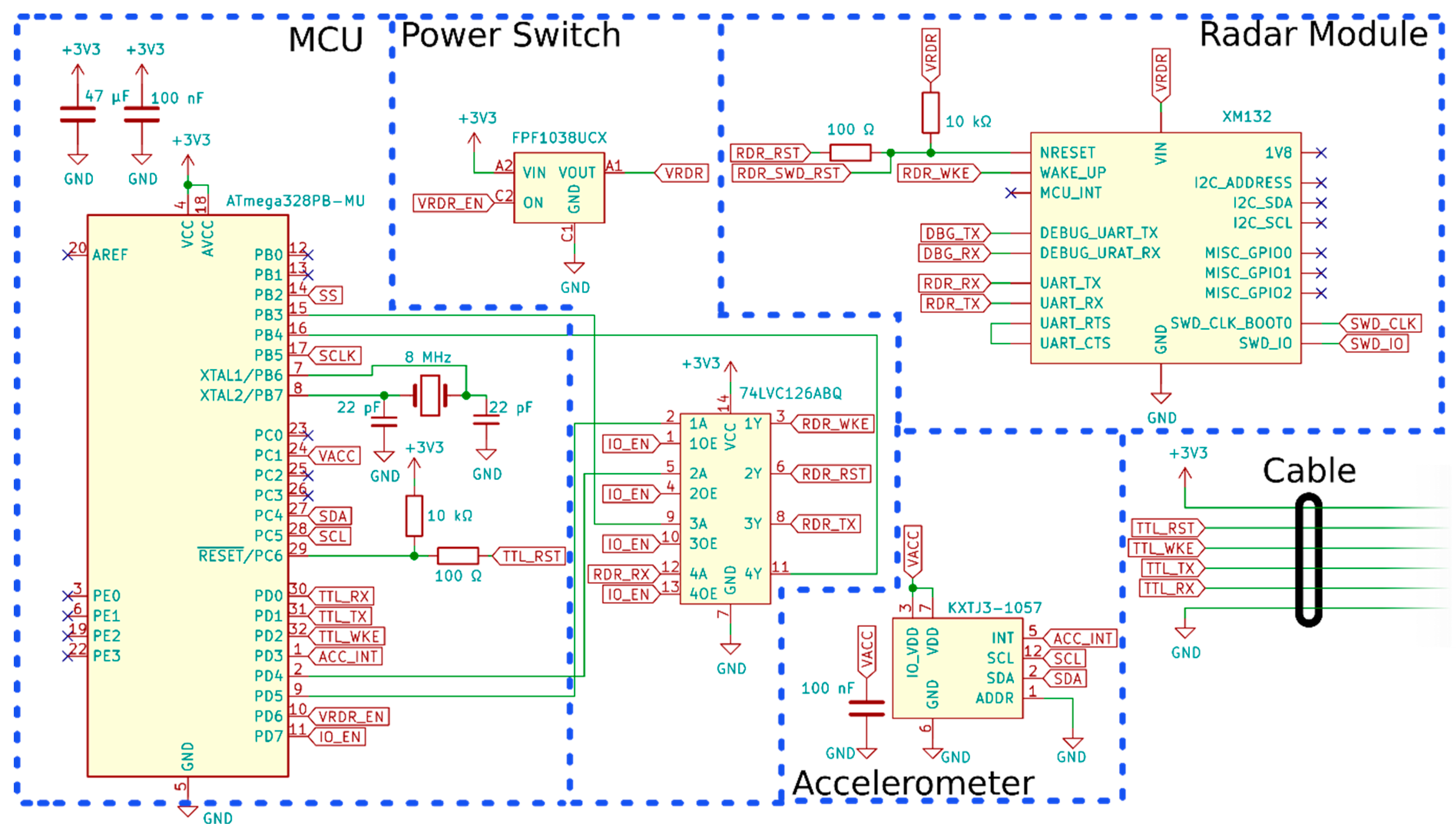

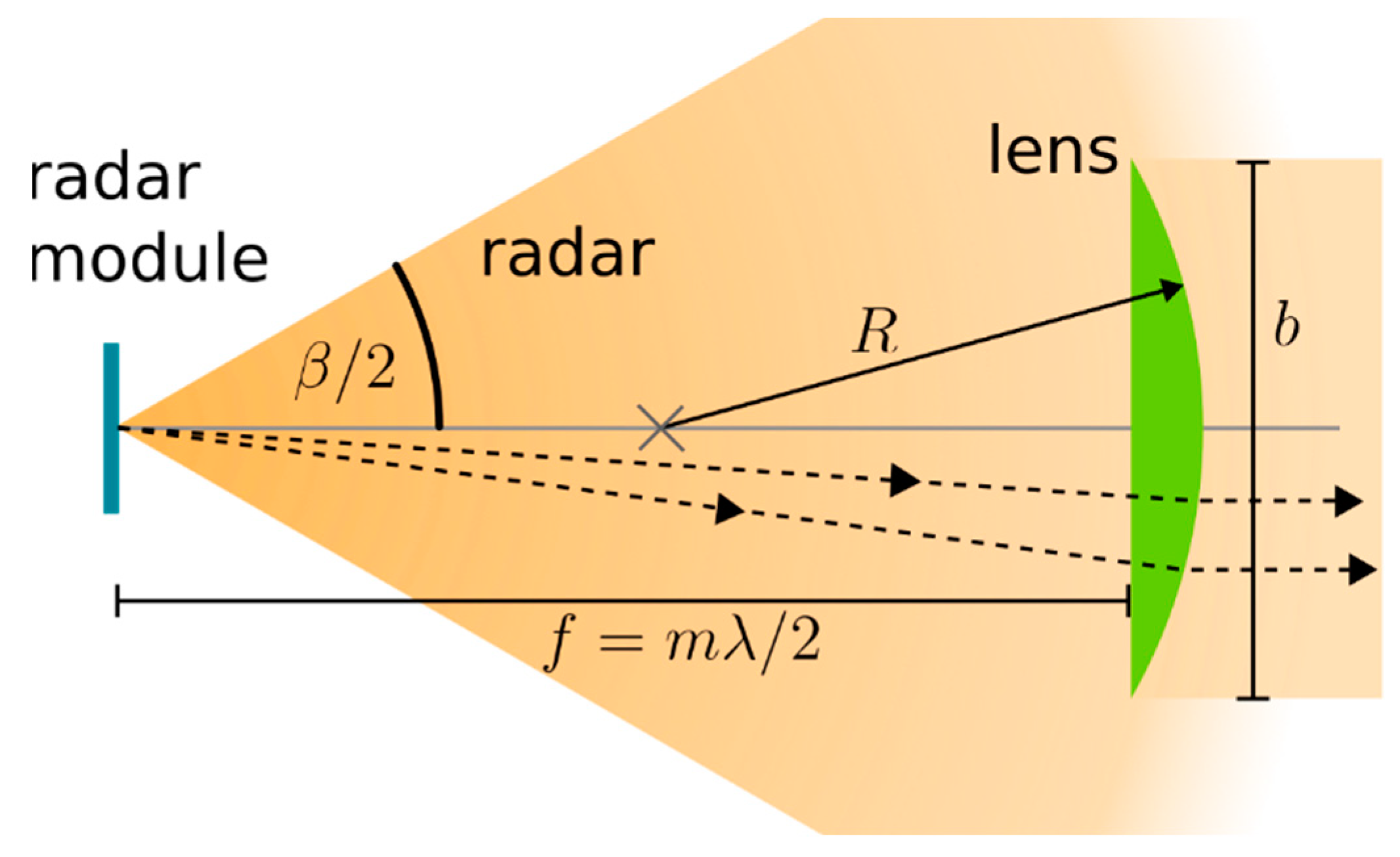
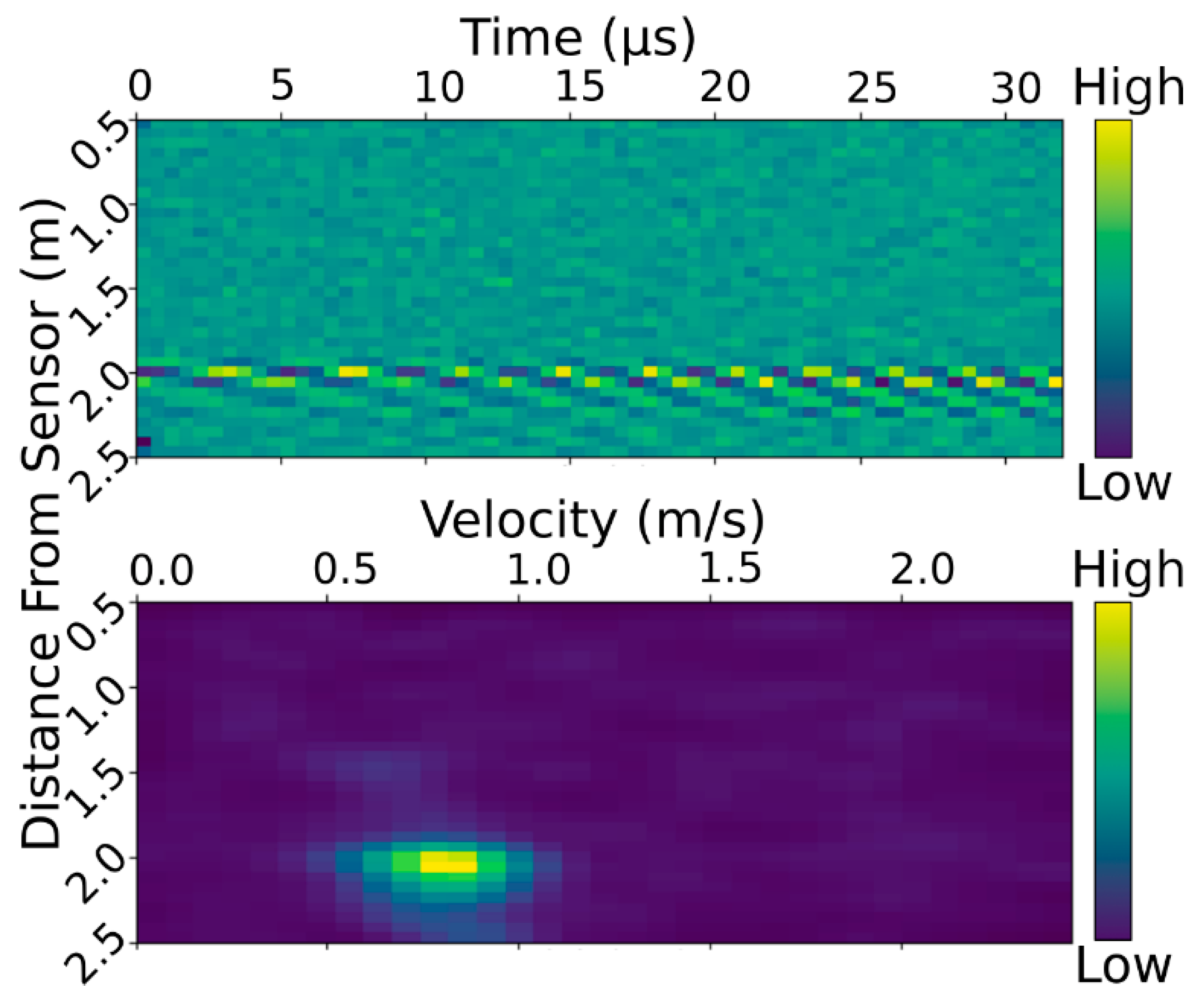
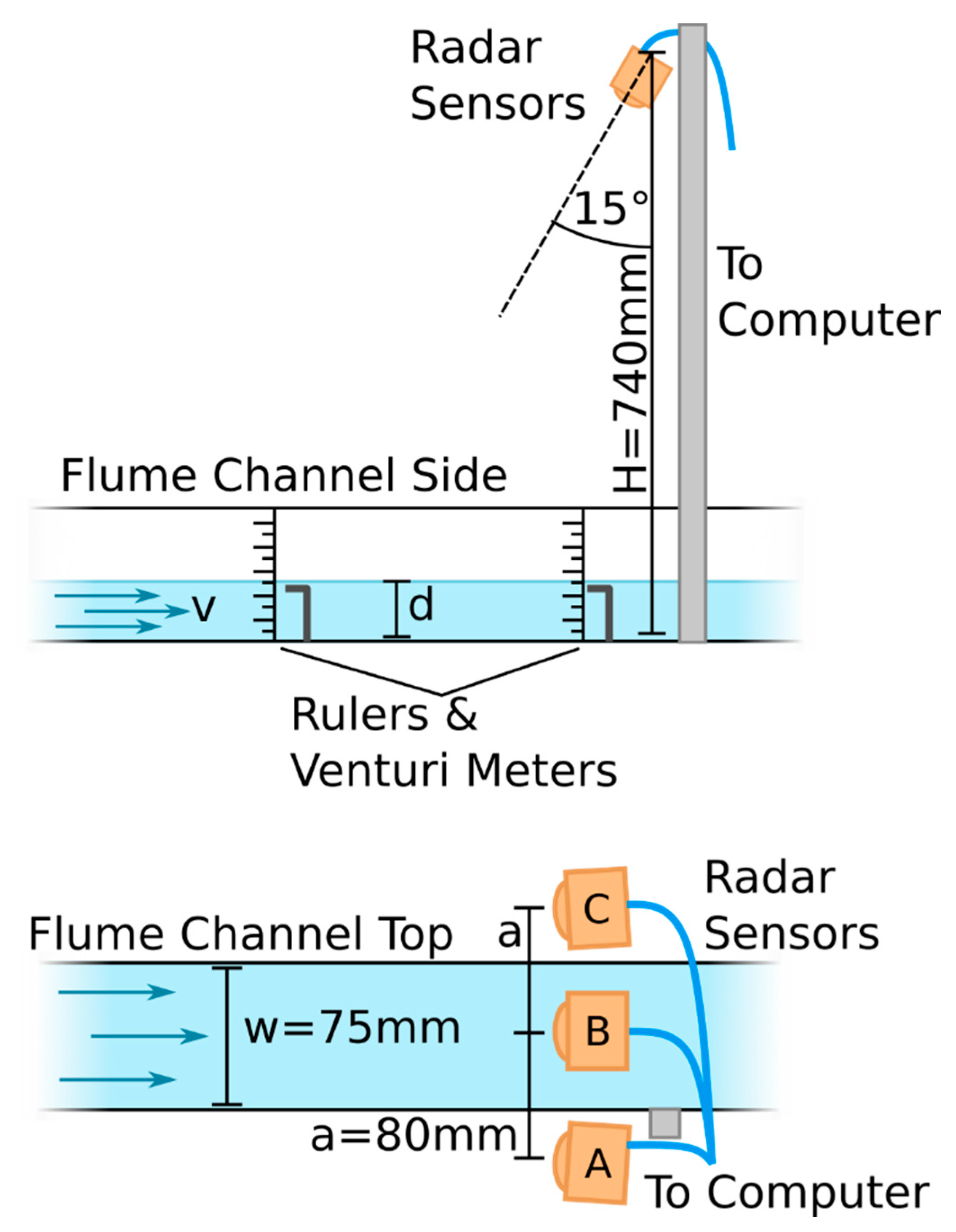


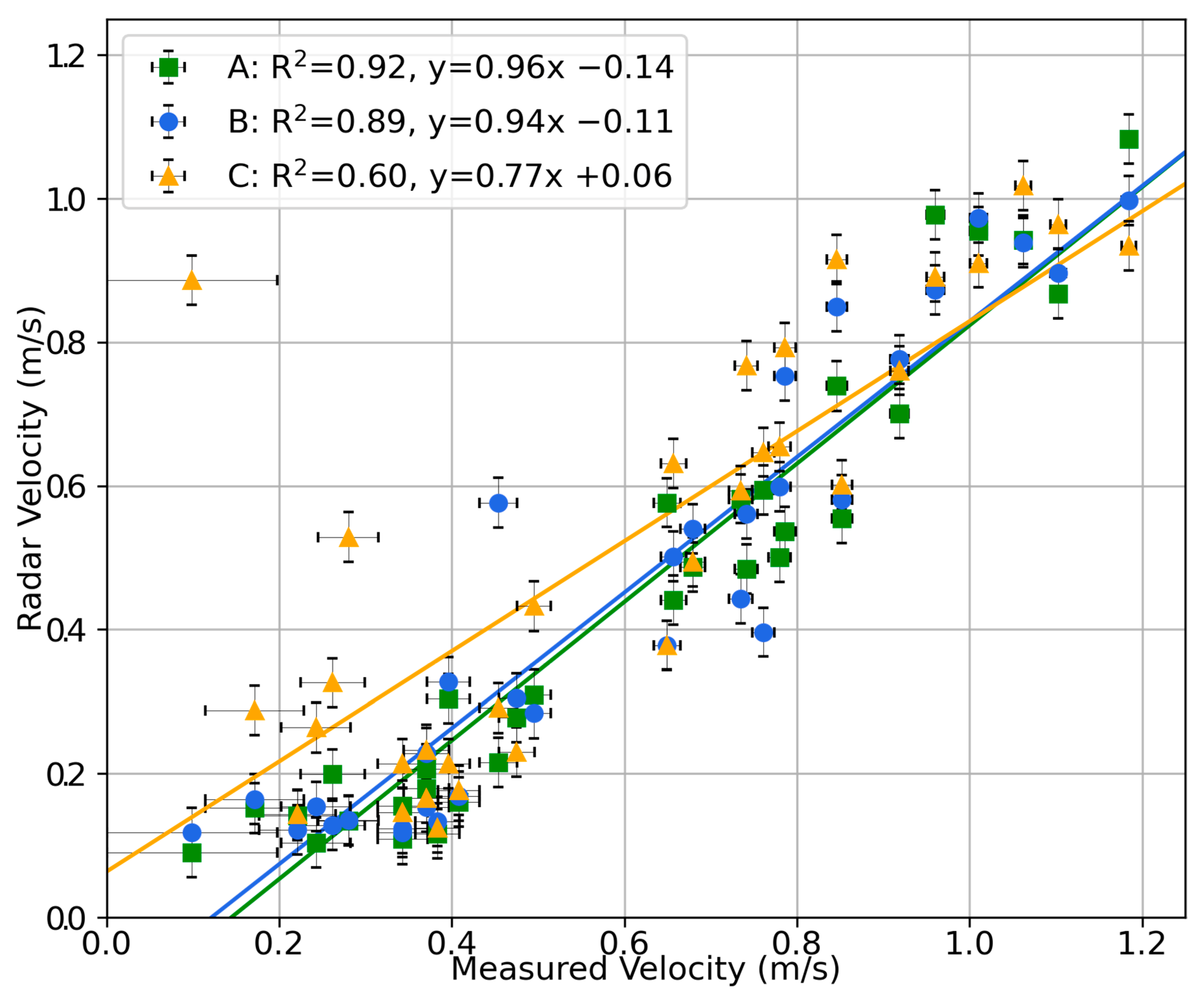
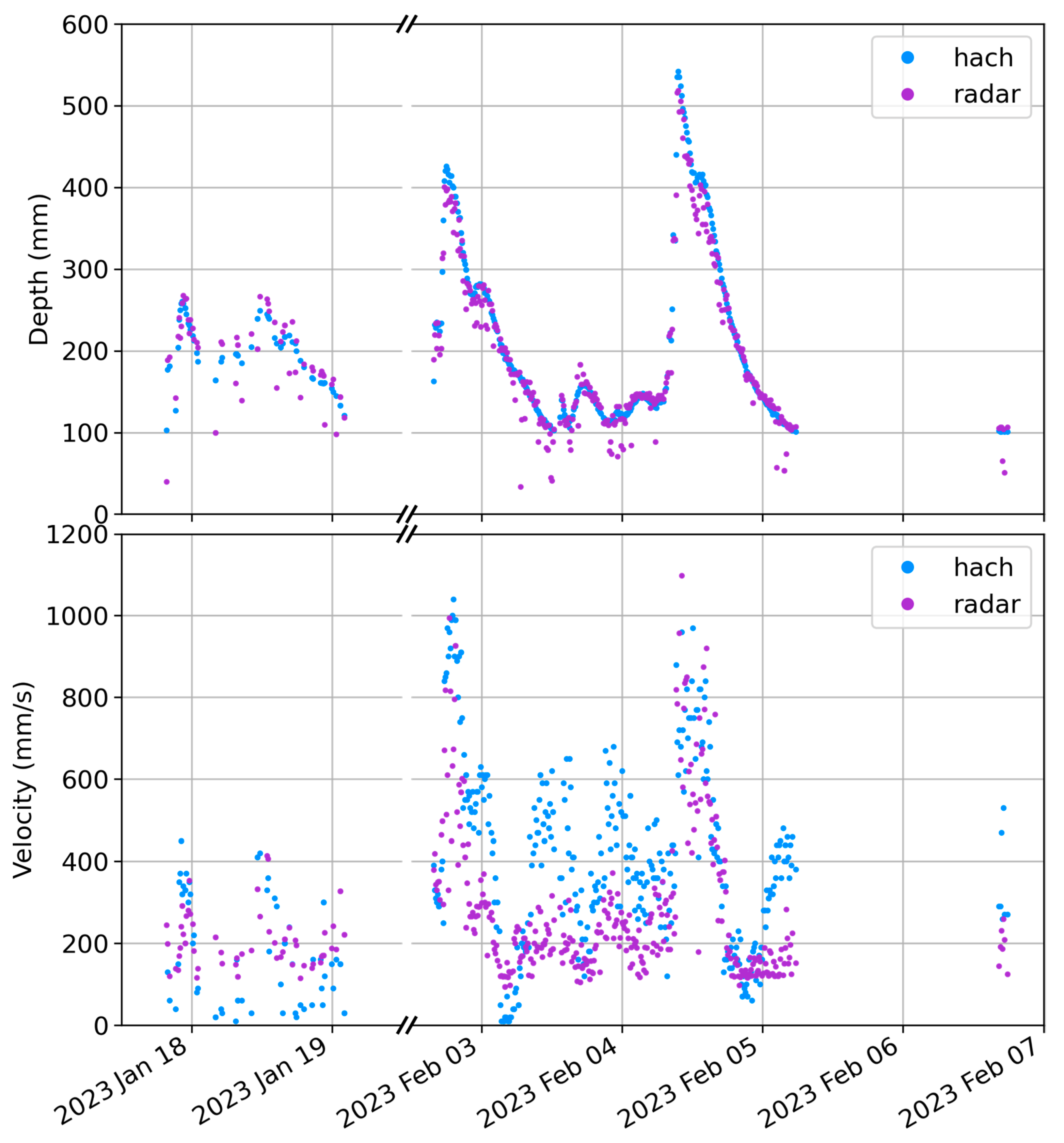
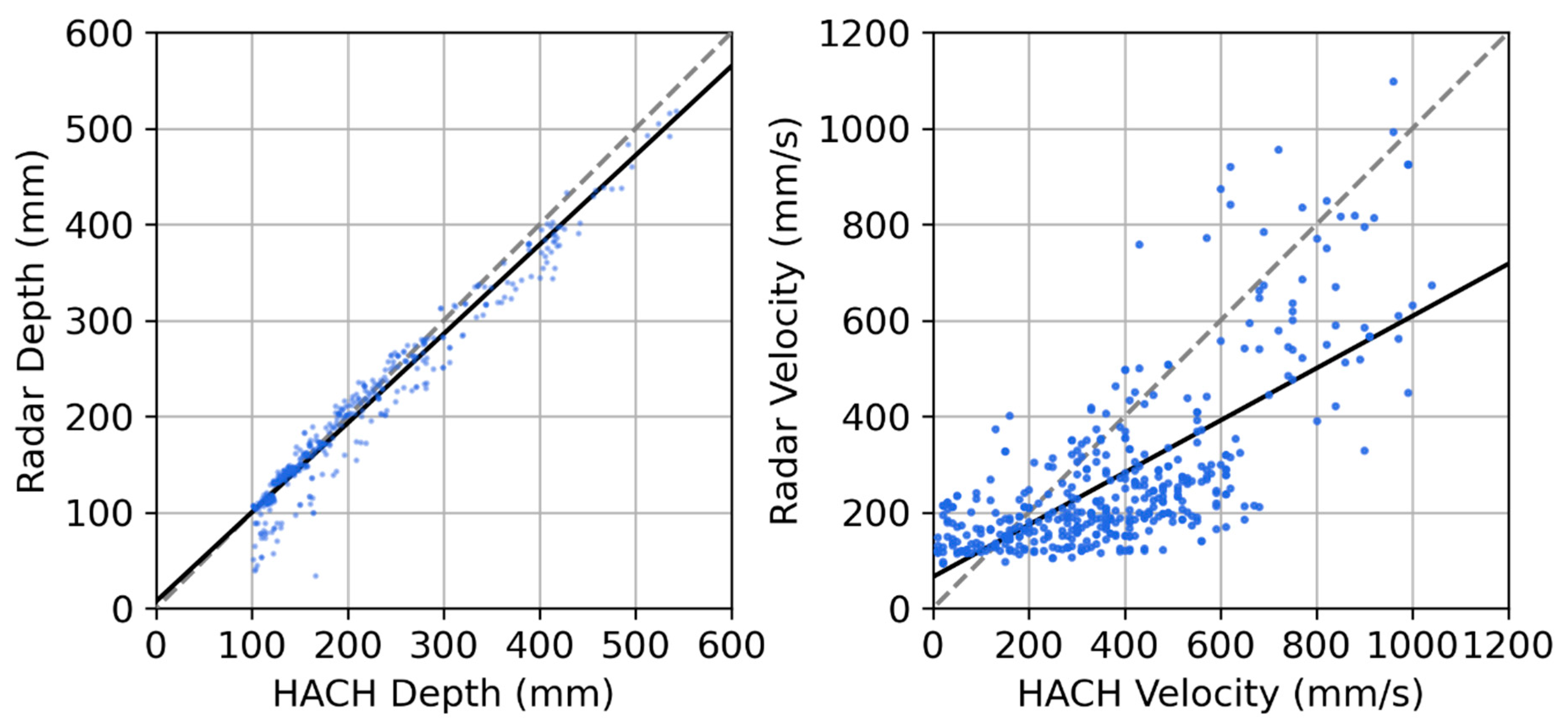
| Ref. | Use | State | Type | Cost | Velocity Uncertainty | Uncertainty Method |
|---|---|---|---|---|---|---|
| This work | Out-of-water | Field-ready | 60 GHz radar | <50 USD | 36% | MAE (field) |
| [35] | Out-of-water | Prototype | 24 GHz radar | n.a. | 8% @ 1.2 m/s | Spot difference (field) |
| [22] | In-water | Field-ready | Acoustic Doppler | <50 USD | 43% | RMS (field) |
| [31] | UAV | Field-ready | Image velocimetry | n.a. | 25% | MAE (field) |
| [28] | UAV | Field-ready | Image velocimetry | n.a. | 13% | MAE (field) |
| [34] | Out-of-water | Prototype | 24 GHz radar | <50 USD * | −3% @ 1.4 m/s −11% @ 1.2 m/s | Mean error (field) |
| [29,52] | Out-of-water (handheld) | Field-ready | 24 GHz radar | 1500 USD | 25% | Local error (field) |
Disclaimer/Publisher’s Note: The statements, opinions and data contained in all publications are solely those of the individual author(s) and contributor(s) and not of MDPI and/or the editor(s). MDPI and/or the editor(s) disclaim responsibility for any injury to people or property resulting from any ideas, methods, instructions or products referred to in the content. |
© 2023 by the authors. Licensee MDPI, Basel, Switzerland. This article is an open access article distributed under the terms and conditions of the Creative Commons Attribution (CC BY) license (https://creativecommons.org/licenses/by/4.0/).
Share and Cite
Catsamas, S.; Shi, B.; Wang, M.; Xiao, J.; Kolotelo, P.; McCarthy, D. A Low-Cost Radar-Based IoT Sensor for Noncontact Measurements of Water Surface Velocity and Depth. Sensors 2023, 23, 6314. https://doi.org/10.3390/s23146314
Catsamas S, Shi B, Wang M, Xiao J, Kolotelo P, McCarthy D. A Low-Cost Radar-Based IoT Sensor for Noncontact Measurements of Water Surface Velocity and Depth. Sensors. 2023; 23(14):6314. https://doi.org/10.3390/s23146314
Chicago/Turabian StyleCatsamas, Stephen, Baiqian Shi, Miao Wang, Jieren Xiao, Peter Kolotelo, and David McCarthy. 2023. "A Low-Cost Radar-Based IoT Sensor for Noncontact Measurements of Water Surface Velocity and Depth" Sensors 23, no. 14: 6314. https://doi.org/10.3390/s23146314
APA StyleCatsamas, S., Shi, B., Wang, M., Xiao, J., Kolotelo, P., & McCarthy, D. (2023). A Low-Cost Radar-Based IoT Sensor for Noncontact Measurements of Water Surface Velocity and Depth. Sensors, 23(14), 6314. https://doi.org/10.3390/s23146314







